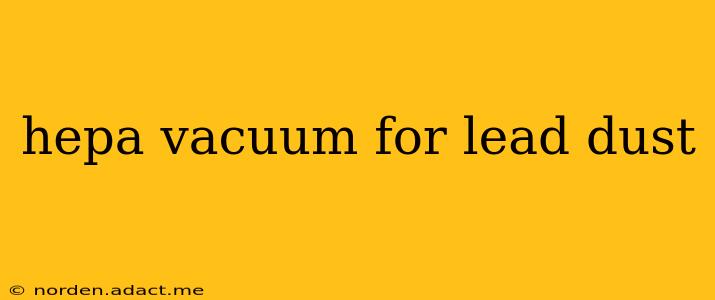Lead dust poses a serious health risk, particularly to children. Inhalation or ingestion can lead to developmental problems, neurological damage, and other severe health issues. Therefore, proper cleanup and containment are crucial during any lead remediation project. A key component of this process is using the right vacuum cleaner – specifically, one equipped with a High-Efficiency Particulate Air (HEPA) filter. This guide will explore the crucial role of HEPA vacuums in lead dust removal and help you choose the best one for your needs.
What Makes a HEPA Vacuum Ideal for Lead Dust?
HEPA filters are designed to capture at least 99.97% of particles 0.3 microns or larger in size. Lead dust particles are often smaller than this, making a HEPA filter essential for effective removal. Standard vacuum cleaners simply don't have the filtration capabilities to trap these microscopic particles, potentially releasing them back into the air during cleaning. A HEPA vacuum, however, effectively traps lead dust, preventing its recirculation and minimizing exposure.
Choosing the Right HEPA Vacuum for Lead Dust Removal
Selecting the right HEPA vacuum for lead dust removal requires careful consideration. Here are some key features to look for:
- HEPA filter certification: Ensure the vacuum's HEPA filter is certified by a reputable organization, proving its effectiveness in capturing particles. Look for certifications like those from the HEPA filter manufacturers and testing bodies.
- Sealed system: A sealed system prevents air from bypassing the HEPA filter, ensuring all air passes through the filter for complete filtration. Look for vacuums with specialized seals and construction designed to prevent leakage.
- Vacuum type: For lead dust removal, a wet/dry vacuum is often preferred. These vacuums can handle both dry dust and any spills or wet cleanup needed during remediation.
- Power and suction: Sufficient suction power is crucial for effective lead dust removal. Consider the size of the area you need to clean and choose a vacuum with adequate power.
- Portability: Depending on the worksite, portability is a vital factor. A lightweight, maneuverable vacuum can enhance efficiency, especially in tight spaces or when cleaning multiple areas.
H2: How Often Should I Replace the HEPA Filter in My Lead Dust Vacuum?
The frequency of HEPA filter replacement depends on several factors, including the intensity of use and the amount of lead dust encountered. Always refer to the manufacturer's instructions for the recommended replacement schedule. However, in cases of heavy lead dust exposure, it’s wise to replace the filter more frequently to maintain peak performance and prevent filter clogging, which could compromise its ability to capture fine particles. Always replace the filter carefully, following the manufacturer’s instructions.
H2: Are Bagless or Bagged HEPA Vacuums Better for Lead Dust?
Both bagless and bagged HEPA vacuums can effectively remove lead dust when equipped with a certified HEPA filter. However, bagged vacuums offer some advantages in lead remediation scenarios. The sealed bag provides a second layer of containment for the lead dust, minimizing the risk of accidental release during filter changes. Bagless vacuums require emptying the dust canister, which presents a greater risk of exposure if not handled correctly.
H2: Can I use a standard shop vacuum for lead dust cleanup?
No, you should never use a standard shop vacuum for lead dust cleanup. Standard shop vacuums are not designed to capture fine particles like lead dust, and their filters are not effective at trapping these hazardous materials. Using a standard shop vacuum increases the risk of dispersing lead dust into the air, creating a more dangerous environment.
H2: What safety precautions should I take when using a HEPA vacuum for lead dust?
Always wear appropriate personal protective equipment (PPE) when working with lead dust, regardless of the vacuum cleaner used. This includes:
- Respirator: A properly fitted N95 or higher-rated respirator will protect your respiratory system from lead dust inhalation.
- Gloves: Wear disposable gloves to prevent skin contact with lead dust.
- Eye protection: Safety glasses or goggles should be worn to protect your eyes from dust particles.
- Protective clothing: Cover your skin with long sleeves and pants to minimize exposure.
- Proper ventilation: Ensure adequate ventilation in the work area. If possible, work outdoors or use exhaust fans.
Using a HEPA vacuum specifically designed for lead dust removal, coupled with appropriate safety measures, is crucial for ensuring a safe and effective lead remediation process. Remember that professional lead abatement should always be considered for extensive lead contamination. This information is for educational purposes and should not replace professional advice.
